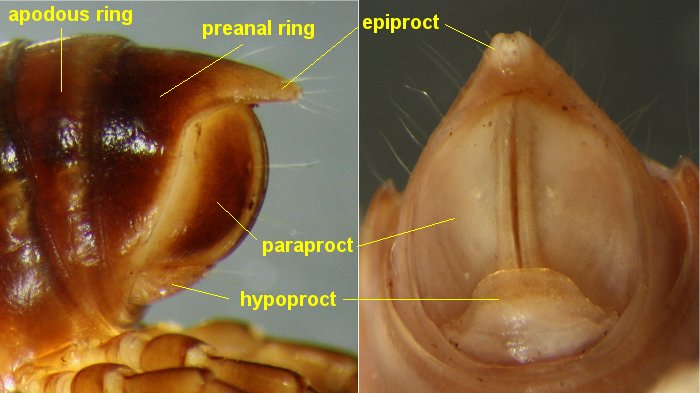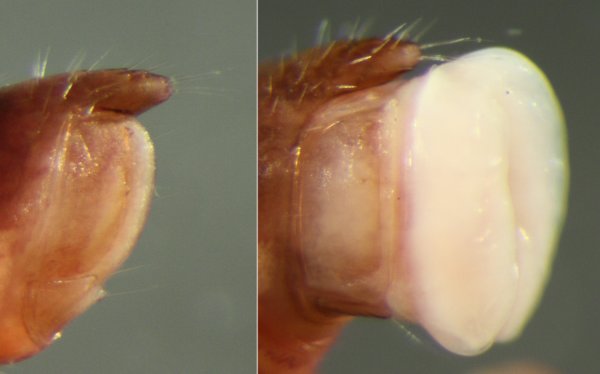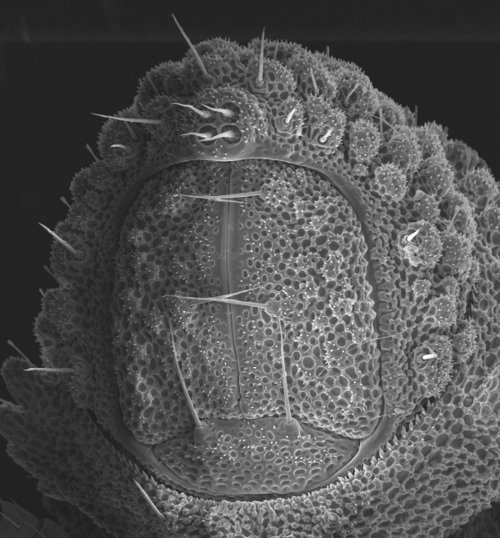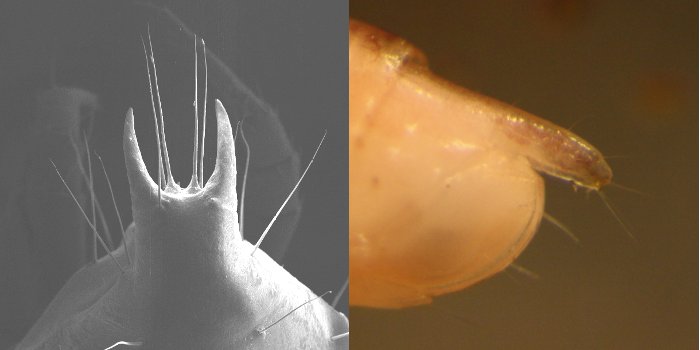Back to: paranota
Forward to: sculpture
Tail
The tail end of a polydesmidan's body is called the telson (see the body plans page). It is made up of the preanal ring, the two paraprocts and the hypoproct (see images below). The top of the preanal ring extends posteriorly as the epiproct.

Left: Somethus tasmani (Paradoxosomatidae), Tasmania
Right: Tasmanopeltis grandis (Dalodesmidae), Tasmania.
The paraprocts (sometimes called the anal valves) are like a pair of doors that close off the anus, and the hypoproct (sometimes called the subanal scale) is like a latch that keeps the doors closed. The hypoproct swings down when the paraprocts swing open (see images below).

Tasmaniosoma hickmanorum (Dalodesmidae), Tasmania. Preserved specimens showing the telson with the paraprocts closed (left) and open (right). Some Polydesmida can evert the rectum, as shown here, when the paraprocts swing outwards.
Telson structure varies only a little in Polydesmida, apart from surface sculpturing. In species in which both the head and tail face the ground, the epiproct is very short but the telson is otherwise unmodified (image below).

Agathodesmus steeli (Haplodesmidae), New South Wales, Australia. Ventral view of ground-facing telson.
Note the square array of four spinnerets on the much-reduced epiproct.
The paraprocts vary least in most Polydesmida (but are apparently in 2 sections in the cave species Dobrodesmus mirabilis from Brazil; see Shear et al. 2016). There are two large setae on each paraproct, close to the median edge where the paraprocts meet. Some diagnostic descriptions of Paradoxosomatidae say that in this family one or both of these setae are further from the margin of the paraprocts than in other Polydesmida, but the differences are unreliable.
The free edge of the hypoproct varies in outline from rounded-triangular to sharply truncated. There are two large setae in the positions shown above (Agathodesmus image), and these setae often arise from nipple-like projections.
Most of the variation in the telson is in the shape and size of the epiproct. Viewed from above or below, the epiproct can be wide or narrow, slightly pointed or broadly blunt, or even forked (below, left). Viewed from the side, the epiproct can be very short (especially in species with a ground-facing telson) or fairly long (below, right), extending well past the paraprocts.

Left: Paredrodesmus bicalcar (suborder Dalodesmidea), Tasmania
Right: Gasterogramma psi (Dalodesmidae), Tasmania.
Shear, W.A., Ferreira, R.L., Iniesta, L.F.M. and Marek, P. 2016. A millipede missing link: Dobrodesmidae, a remarkable new polydesmidan millipede family from Brazil with supernumerary rings (Diplopoda, Polydesmida), and the establishment of a new suborder Dobrodesmidea. Zootaxa 4178(3): 371-390.
Back to: paranota
Forward to: sculpture
